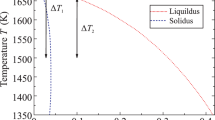Abstract
The main provisions of the phase-field method for concentrated solutions and the problems of numerical modeling of a thermodynamically consistent model of the dynamics of the order parameter for phase transformations of the first kind in the framework of the phase-field approach are briefly considered. The model is based on extended irreversible thermodynamics, which uses Gibbs potentials of real systems to describe the state of the system. Numerical algorithms for modeling phase-field equations for both locally equilibrium and locally nonequilibrium models of relaxation dynamics are derived from the gradient-stability condition, which guarantees a decrease in the free energy of the system during relaxation. The estimates of the eigenvalues of the Hessian matrix in the lattice space allow us to construct a gradient-stable algorithm for modeling the time evolution of the phase-field equations in real thermodynamic systems, despite the existing differences in Gibbs energies. The paper analyzes gradient-stable numerical schemes for stability to small deviations for phase field equations in the Fourier approximation. The numerical calculations performed for the SiAs solution demonstrate the stability of the obtained algorithm both with an increase in the time step by several orders of magnitude, and with an increase in the driving forces due to severe supercooling of the system.




Similar content being viewed by others
REFERENCES
I. Singer-Loginova and H. M. Singer, Rep. Prog. Phys. 71, 106501 (2008). https://doi.org/10.1088/0034-4885/71/10/106501
H. Emmerich, Adv. Phys. 57 (1), 1 (2008). https://doi.org/10.1080/00018730701822522
D. Herlach, P. Galenko, and D. Holland-Moritz, Metastable Solids from Undercooled Melts (Elsevier, Burlington, MA, 2006).
T. M. Rogers, K. R. Elder, and R. C. Desai, Phys. Rev. B 37, 9638 (1988). https://doi.org/10.1007/978-94-011-2540-6_9
B. P. Vollmayer-Lee and A. D. Rutenberg, Phys. Rev. E 68, 066703 (2003). https://doi.org/10.1103/PhysRevE.68.066703
http://cpddb.nims.go.jp/cpddb/periodic.htm. Accessed March 25, 2021.
D. J. Eyre, Preprint “An unconditionally stable one-step scheme for gradient systems” (1997). http://www.math.utah.edu/eyre/research/methods/stable.ps
D. J. Eyre, in Computational and Mathematical Models of Microstructural Evolution, Ed. by J. W. Bullard (Mater. Res. Soc., Warrendale, PA, 1998), p. 39.
M. Cheng and J. A. Warren, Phys. Rev. E 75, 017702 (2007). https://doi.org/10.1103/PhysRevE.75.017702
M. Cheng and J. A. Warren, J. Comput. Phys. 227, 6241 (2008). https://doi.org/10.1016/j.jcp.2008.03.012
M. Cheng, S. Cottenier, and H. Emmerich, arXiv:0807.3579v2 [cond-mat.mtrl-sci] (August 6, 2009).
J. W. Choi, H. G. Lee, D. Jeong, and J. Kim, Phys. A 388 (9), 1791 (2009). https://doi.org/10.1016/j.physa.2009.01.026
V. Lebedev, A. Sysoeva, and P. Galenko, Phys. Rev. E 83, 026705 (2011). https://doi.org/10.1103/PhysRevE.83.026705
P. K. Galenko, V. G. Lebedev, and A. A. Sysoeva, Comput. Math. Math. Phys. 51, 1074 (2011). https://doi.org/10.1134/S0965542511060078
I. Steinbach, L. Zhang, and M. Plapp, Acta Mater. 60, 2689 (2012). https://doi.org/10.1016/j.actamat.2012.01.035
H. F. Wang, P. K. Galenko, X. Zhang, W. W. Kuang, F. Liu, and D. M. Herlach, Acta Mater. 90, 982 (2015). https://doi.org/10.1016/j.actamat.2015.02.021
H. F. Wang, W. W. Kuang, Z. Xiao, and F. Liu, J. Mater. Sci. 50, 1277 (2015). https://doi.org/10.1007/s10853-014-8686-1
X. Zhang, H. F. Wang, W. W. Kuang, and J. B. Zhang, Acta Mater. 128, 258 (2017). https://doi.org/10.1016/j.actamat.2017.02.026
V. G. Lebedev and P. K. Galenko, Russ. Metall. (Metally) 8, 785 (2016). https://doi.org/10.1134/S0036029516080097
http://web.micress.de/. Accessed March 10, 2021.
S. M. Allen and J. W. Cahn, Acta Metall. 27, 1085 (1979). https://doi.org/10.1016/0001-6160(79)90196-2
D. Kessler, J. Cryst. Growth 224 (1–2), 175 (2001). https://doi.org/10.1016/S0022-0248(01)00814-4
P. Galenko and D. Jou, Phys. Rev. E 71, 046125 (2005). https://doi.org/10.1103/PhysRevE.71.046125
J. W. Cahn and J. E. Hilliard, J. Chem. Phys. 28, 258 (1958). https://doi.org/10.1063/1.1744102
V. G. Lebedev, E. V. Abramova, D. A. Danilov, and P. K. Galenko, Int. J. Mater. Res. 101 (4), 473 (2010). https://doi.org/10.3139/146.110297
P. K. Galenko, E. V. Abramova, D. Jou, D. A. Danilov, V. G. Lebedev, and D. M. Herlach, Phys. Rev. E 84, 041143 (2011). https://doi.org/10.1103/PhysRevE.84.041143
S. Li, J. Zhang, and P. Wu, J. Cryst. Growth 312, 982 (2010). https://doi.org/10.1016/j.jcrysgro.2009.12.070
P. K. Galenko and M. D. Krivilyov, Modell. Simul. Mater. Sci. Eng. 8, 67 (2000). https://doi.org/10.1088/0965-0393/8/1/306
B. Bӧttger, M. Apel, M. Budnitzki, J. Eiken, G. Laschet, and B. Zhou, Comput. Mater. Sci. 184, 109909 (2020). https://doi.org/10.1016/j.commatsci.2020.109909
ACKNOWLEDGMENTS
The authors are grateful to A.V. Obukhov for a number of valuable remarks on numerical modeling.
Funding
This study was supported in part by the Russian Foundation for Basic Research and by the administration of the Usmurt Republic (research project no. 18-42-180002).
Author information
Authors and Affiliations
Corresponding author
Additional information
Translated by N. Wadhwa
Rights and permissions
About this article
Cite this article
Lebedev, V.G., Obukhov, A.A., Bovin, V.P. et al. Gradient-Stable Algorithm for the Dynamics of the Phase Field in Modeling of Directional Solidification in Si–As. Tech. Phys. 67, 700–706 (2022). https://doi.org/10.1134/S1063784222100048
Received:
Revised:
Accepted:
Published:
Issue Date:
DOI: https://doi.org/10.1134/S1063784222100048



